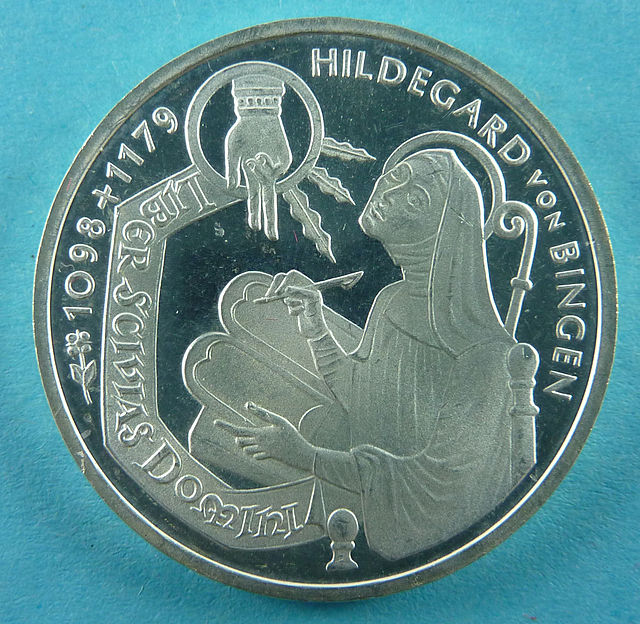The Unheard Voices: Women Hymn Writers and Performers in Medieval Religious Communities
A guest post by Nina Sumner

Creative Commons Zero, Public Domain Dedication, via Wikimedia Commons
While women composers have often been overlooked in the history of music, one visionary nun became an influential figure during the medieval era and still remains an inspiration to female writers and performers to this day. Hildegard of Bingen was one of the first musical personalities expressing devotion through hymns and sequences, making a positive contribution to religious communities with her compositions. While hymn singing wasn’t officially approved by the Church of England until the early 19th century, music has always been an integral component of Christian worship and, in medieval religious communities, women played a significant role in the composition of hymns and sacred music. Although their contributions were often underappreciated, women hymn writers still influenced the musical and devotional life of these communities and made important contributions to hymnody and musical performance in the Middle Ages.
Shaping communities through song
Throughout western music history, women have produced innovative and moving compositions. From songs of praise in the bible attributed to strong and influential women, to contemporary devotional compositions, female hymn writers have contributed significantly to the Christian faith. With their unique perspectives, resilience and devotion, women have also played a vital role in shaping communities. In medieval religious communities, women frequently engaged in the creation of sacred art and music as a means of spiritual devotion, and hymns were a vital component of this multifaceted approach to worship and expression. The Beguines, a medieval religious movement, is just one example of a community where women were supported and inspired to develop their creativity. From the semi-monastic community active in Northwestern Europe from the 13th to 16th centuries, two notable hymn writers and composers emerged. Hadewijch of Antwerp and Mechthild of Magdeburg composed devotional poetry and hymns that were an integral part of their spiritual expression and community life.
Encouraging artistic expression in convents
During the Middle Ages, exclusively female, cloistered religious communities offered a place for intellectual women to pursue the arts including musical composition. In the first six hundred years of Christian worship, women often had more authority in these communities and other more domestic spaces where it was practiced. Hildegard of Bingen was one of the most notable women hymn writers of the medieval period. She became the abbess of her own Benedictine convent where, as well as taking care of her sisters and sharing her spiritual wisdom, she spent her time composing a large body of musical work including hymns, antiphons and sequences. Her compositions often reflected her visionary experiences and theological insights. Some of her most famous works include ‘O ignee spiritus’ and ‘O viriditas digiti Dei.’ Her music continues to be celebrated for its haunting beauty and spiritual depth.
Enriching scholarly works with music composition
Another German Abbess, Herrad of Landsberg, also recognized the importance of music and hymns in her scholarly work. Although not first and foremost known as a musical composer, she included hymns and musical notations in her illustrated encyclopedia the ‘Hortus Deliciarum’, demonstrating the integration of music in the educational and devotional life of her community. Other influential female figures in medieval religious music were primarily poets and illustrators, writing devotional pieces reflecting their engagement with religious themes. Guda of St Maria was a 12th century nun noted for her hymn ‘O splendidissima gemma’, a piece dedicated to the Virgin Mary, the subject of another musical sequence composed by the poet and hymn writer Marie de France. These women, among others, defied social and cultural norms to assert their creative and spiritual voices through the writing of hymns and other musical compositions within the context of medieval religious communities. Their works continue to resonate through the centuries, offering a glimpse into the diverse and significant roles of women in shaping the spiritual expression of their time.
While the names of many women hymn writers in medieval communities may not be as widely recognized as those of their male counterparts, the influence and significance of their contributions to sacred music and religious expression should not be underestimated. Their hymns and compositions enriched the devotional practices of their communities and continue to resonate with audiences today.
For more on influential women of church history, check out issues #131 Women of the Reformation and #30 Women in the Medieval Church.



